What Are Gold “Macro Factors” And Why Do They Matter?
Posted on — Leave a commentYear-to-date gold has risen approximately 11% and much of this performance traces back to macro factors.
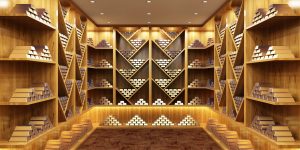
Macro-economic factors are characteristics of the economy that have widespread impact. Put simply, macro factors are the big numbers that we all care about like unemployment, inflation, and national income. Recently, three specific macro factors have driven the value of gold. They are:
The Value of the Dollar
When the value of the dollar drops the price of gold often climbs. The reason for this inverse relationship is that a drop in the value of the dollar means that gold becomes less expensive in other currencies. This dynamic explains why the inverse relationship developed after the US suspended the gold standard in 1933. This decision was designed to help pull the country out of the Great Depression, which many historians and economists believe it did.
This relationship is not a constant. There have been periods, though few, in which the value of the dollar and the value of gold has increased simultaneously. This event can occur during a period of economic upheaval in the global economy in which investors seek the relative stability of both gold and the US dollar. In fact, reporting from The World Gold Council shows that the IMF “estimated in 2008 that 40-50% of the moves in the gold price since 2002 were dollar-related, with a 1% change in the effective external value of the dollar leading to a more than 1% change in the gold price.”
Decreasing Yields
Many believe that there is a negative correlation between interest rates and the price of gold. The reasoning behind this belief is simple: investors want a return on their money and falling interest rates mean fixed-income investments deliver less. Gold, in comparison, becomes a more attractive investment.
In truth, this correlation is not nearly as strong as many think it is. In fact, the correlation may not exist at all. Consider that measurements over the last 50 years show that the correlation between gold and interest rates has only been at 28%. This figure hardly represents a strong correlation. Despite this weak correlation, in the limited view of the recent gold rally, it appears that falling rates have in fact driven investors to the relatively stronger return of gold.
Recession Fears
Recently, the yield curve became inverted. This inversion means that short-term cash instruments are paying out more than the longer-term ones. This is counter-intuitive because one would expect to earn more when they lock up their assets for longer. The reason for an inversion is that people have fears about the near-term and they are demanding more money for weathering what they believe is the coming storm.
More importantly, the yield curve has been inverted for more than three consecutive months. This period of time matters because a three-month inversion has preceded every recession over the past five decades. There are many factors behind this long-standing inversion like faltering trade agreements, a slowing manufacturing sector, and tempered consumer sentiment.
As the executive director of precious metals research at Standard Chartered Bank recently remarked, “There’s still much more room to the upside, particularly when it comes to retail demand.” The macro factors have spoken and the message is clear: consider the stability and return of gold.
Judy Shelton: A Gold Bug May Get a Seat at the Fed’s Table
Posted on — Leave a comment“We make America great again by making America’s money great again,” – Judy Shelton, President Trump’s nominee to be a Federal Reserve governor.
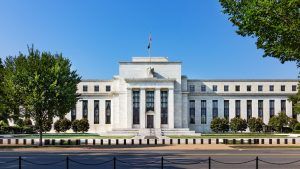
The quiet movement to return to the gold standard is getting louder.
Six states passed laws recognizing gold and silver as currency since 2011. The Republican Party called for a commission to explore the viability of a return to the gold standard in both its 2012 and 2016 campaign platforms.
The gold standard, of course, is a system that ties the value of a country’s currency to gold. First adopted in the United States back in 1879, Americans were allowed to exchange paper money for physical gold.
While there are positives to the gold standard, there are also negatives, as a country can only issue as much money as it has gold. President Nixon ended U.S. dollar-gold convertibility in 1971 as foreign holdings of dollars grew larger than America’s gold reserves, which left the country vulnerable to a run on its currency.
New Fed Nominee
This week, President Trump nominated Judy Shelton, the U.S. executive director at the European Bank for Reconstruction and Development, for an open seat on the seven-member Federal Reserve Board of Governors.
- Shelton is a sharp critic of the Federal Reserve who wants to reshape the U.S. monetary system. She is loud proponent for lower interest rates and advocated for a gold currency peg throughout her career.
- She advocates that a return to a fixed-currency peg would create conditions for a more even playing field in international trade.
“Money is a moral contract between the government and individual citizens,” Ms. Shelton told a group of reporters at the Trump Hotel in May. “Someone called me a gold bug — what would I rather be? A Fed bug?”
Last year, Shelton wrote a piece for the journal of the Cato Institute, a libertarian think tank. In her words:
“In proposing a new international monetary system linked in some way to gold, America has an opportunity to secure continued prominence in global monetary affairs while also promoting genuine free trade based on a solid monetary foundation. Gold has historically provided a common denominator for measuring value; widely accepted at all income levels of society, it is universally acknowledged as a monetary surrogate with intrinsic value.”
She also wrote: “The United States is the world’s largest holder of official gold reserves. Comprising 8,311.5 tonnes or 261 million troy ounces, those reserves are carried at a book value of roughly $11 billion. Notably, the market value is significantly higher at $345 billion (based on the London Gold Fixing for September 30, 2016).”
Given that the U.S. currently owes $22 trillion in U.S. Treasury debt, how would a return to the gold standard be reconciled? Would the price of gold be repriced dramatically higher to match the value of the nation’s swollen debt? A return to the gold standard wouldn’t necessarily require a 1:1 convertibility value. There could a percentage in which the dollar is backed to the amount of gold reserves a country holds.
No matter how a gold peg would be calculated, this would no doubt be an extremely bullish development for the precious metal.
Digging Deeper
Since 1973 when President Nixon ended the gold standard, U.S. dollars get their value through the backing of the federal government. The Federal Reserve can expand the money supply and print unlimited amounts of money with no peg to physical gold.
Other proponents of the gold standard argue that it would limit government spending to only what it raises in taxes or can borrow against its gold reserve. This would certainly rein in spending, but that could result in consequences and potential spending cuts for big government programs like Social Security and Medicare. Another potential downside is that a country on the gold standard would have less flexibility to address financial crises or support economic downturns.
Proponents of the gold standard point to the U.S. Constitution itself for support in tying gold to U.S. dollars. Sections 8 and 10 of Article I state that Congress has the “Power…to coin Money, regulate the Value thereof, and of foreign Coin,” while “no state…shall make any Thing but gold and silver Coin a Tender in Payment of Debts.”
What’s Next?
Shelton’s monetary beliefs are outside mainstream economics and she will be scrutinized by Senate lawmakers, who will need to approve Shelton for the seat on the Fed board.
Nonetheless, with the nomination of Judy Shelton, President Trump has swung open the doors to the Federal Reserve. He is giving a renowned proponent of the gold standard a seat at a powerful table with the opportunity steer the country’s monetary policy in the years ahead.
This Coin Features a Mistake
Posted on — Leave a commentLook at the coin below. Do you see the mistake? This 1797 $10 Draped Bust Large Eagle was a bit of a controversy at the time.
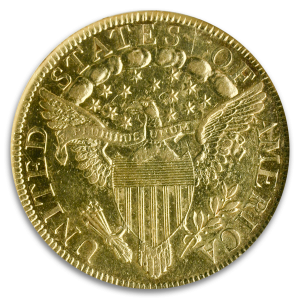
It’s in the olive branches and arrows that the eagle clutches in his talons. You’ll notice that the olive branches are in his left (sinister) claw and the arrows in his right (dexter) claw. “Dexter” signifies more honorable and “sinister” less honorable, so the heraldic meaning is essentially that war is more honorable than peace. Whoops!
If you look at a dollar bill, you’ll notice that the heraldry there has been fixed, with the eagle having olive branches in his right claw and arrows in his left.
But was it really a mistake after all? Let us consider the XYZ Affair (yes, that is its real name), a little-known souring of American-French relations.
In 1793, France went to war with the United Kingdom while America stayed neutral. We signed the Jay Treaty with the UK, which resolved outstanding issues from the American Revolution. France was none too happy about this, believing it violated treaties between the U.S. and France, so it seized a substantial number of American merchant ships. President John Adams sent a diplomatic delegation to France to parley, but the French foreign minister refused to see them, insisting they first pay him a large bribe, among other conditions.
Outrage spread in the U.S. once this became known, and Adams released a report of the affair to Congress, replacing the names of the French agents involved with the letters, X, Y, and Z. Congress enacted various defense measures, including creating the Department of the Navy, and authorized American ships to attack French ships, thus launching an undeclared war called the Quasi-War (again, its real name).
Hostilities were settled in 1800, but the legacy remains: some believe that the “mistake” on the $10 Draped Bust Large Eagle was no mistake at all, but a sign to France and others: don’t mess with us.
That’s not the only reason this is a special coin: the 1797 mintage is quite low — only 10,940 coins. Additionally, an uncirculated specimen resides in the National Numismatic Collection at the Smithsonian. And finally, it’s the largest format gold coin of the era, measuring 33 mm (1.3 inches) across. Because of its high intrinsic value (that’s a lot of gold), it saw little everyday use.
Are you looking to find the perfect rare coin? Take a look at our products and give us a call. We’re happy to help.
Evolving Our National Identity with the 1907 $10 Indian Head
Posted on — Leave a comment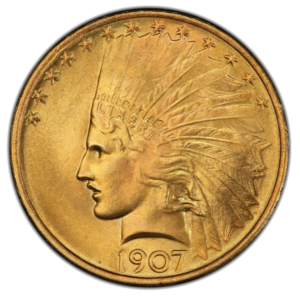
It was 1904 and the United States of America was finding its 20th century identity.
President Roosevelt felt that part of this emerging identity must acknowledge native Americans. It was then that he realized that the Liberty Head gold coin series had remained unchanged for more than 25 years. That length of time was important because it meant that he could alter the design without an act of Congress. It was then that he had the idea for what would later become the Indian Head Eagle. He remarked, “I feel very strongly that on at least one coin we ought to have the Indian feather headdress. It is distinctly American.”
By 1907, Roosevelt contacted sculptor Augustus Saint-Gaudens who began working on the design. Saint-Gaudens turned to one of his previous, unused works as inspiration; the statue of Victory in the William Tecumseh Sherman Monument in New York City. The profile would become the basis for one side of the coin. Saint-Gaudens modified the profile to include the beautiful headdress.
In sculpting the piece, he had to tread a fine line; he wanted a relief that was bold, but if it was too prominent it would not strike properly at the mint. It was not long after this design work was nearly complete that Saint-Gaudens died, leaving the coin as one of his lasting embellishments on the country’s national identity.
Soon other designers took over to complete Saint-Gaudens work. They reduced the relief slightly to accommodate the presses at the mint. They also added a rim to the coin, a thin, raised ring encircling the perimeter. This change was driven more by functional needs than artistic interests. Without the rim the coin was underweight and prone to coming off the dies with extrusions surrounding he edges.
Initially, the mint struck approximately 500 pieces using Saint-Gaudens original design. These pieces, which became known as “wire rim” pieces, were available for purchase from the mint until 1912. Today, they remain a rare collector’s item with one piece earning $230,000 at auction as recently as 2011.
Later, a much larger issuance of 32,000 coins were struck using the modified dies. However, new Mint Director Frank Leach decided to melt nearly all of these pieces, keeping only 50. This decision made the issuance exceedingly rare. As a result, one of these coins, a piece held within the Leach family, commanded $2,185,000 at an auction in 2011.
Eventually, the mint issued a new set. However, it was long after that the public began to vocalize their dissatisfaction with the decision to omit the words, “In God We Trust” on the eagle. The original decision to remove the words came from Roosevelt who believed such a design to be sacrilegious. The public’s reproach was strong enough to result in a bill from the House of Representatives which mandated that the words be included on the new eagle and double eagle designs. Soon after, President Roosevelt, under increasing pressure, signed the bill into law.
Today, the numerous versions of the 1907 $10 Indian coin are a reminder that new coin issuance’s are as much of an iterative process as the forming of our national identity.
This Is a Major Buy Signal in Gold
Posted on — Leave a commentYou’ve heard the saying that a picture is worth 1000 words? Investors and traders use “pictures” of market action to project where that market is going next.

Right now, the picture in gold is explosively bullish.
Gold is breaking out of a major basing pattern on the monthly gold chart that suggests an epic rally phase is starting.
A gold chart is simply a “picture” of historical price action. There are traders and investors who solely base their investing decisions based on so-called technical analysis. Here’s why.
There is an old market saying “It is all the in charts.”
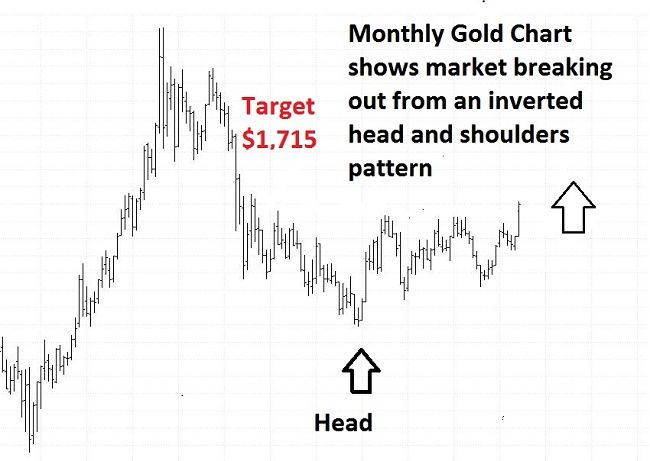
That means that all known “fundamental factors” like concerns about an Iran-U.S. war, China-U.S. Trade War worries, fears about a stock market correction and everything else impacting gold is already “priced into the market.”
The three main tenets of technical analysis are:
- All known news is discounted in the current price of gold.
- Gold prices moves in trends.
- History repeats itself.
Every major Wall Street firm has a technical analysis research department and recommendations from the “chartists” are taken just as seriously as those who do macroeconoimc or “fundamental” research.
What are the charts saying about gold right now?
Explosive rally ahead!
Gold just busted out higher with the close above the $1,400 level from a major “inverted head and shoulders” pattern. Funny name, but it’s a powerful pattern.
The “head” or bottom of the pattern formed around December 2015. The “shoulders” of the pattern marked the upper boundary of the trading range for the past six years. Last week, gold confirmed a bullish upside breakout from that pattern.
Patterns analysis works in markets because history repeats itself. People are the ones who trade and invest in financial markets. People are driven by emotions, including fear and greed, and those emotions unfold on the chart in the form of repeatable price patterns.
This gold market pattern also creates an upside target – around $1,715 per an ounce. That’s just a minimum objective, so gold could go much higher.
What’s next? As long as gold continues to hold above the $1,400 level, chart traders will be targeting gains to the $1,715 zone.
This is a veritable “buy signal” for gold. If you want to get on board this bullish investment, call Blanchard today at 1-800-880-4653 for personalized recommendations. Don’t wait. Next month, you will be paying much higher prices to get on board the gold market rally.
When Opportunity Knocks, Will You Listen?
Posted on — Leave a commentThe gold/silver ratio hit 90 last week. That is over a 10-year high in the ratio.

This market signal is a rare occurrence.
But, what does it actually mean?
It means silver is extremely undervalued relative to gold.
Silver is cheap. It’s a bargain right now.
Savvy investors use the gold/silver ratio for a timing signal for entry points for both gold and silver purchases.
The gold/silver ratio is a simple calculation – divide the price of an ounce of gold, by the price of an ounce of silver.
And, this ratio recently touched 90!
Readings above 80 signal that silver is severely undervalued and is a strong buy signal for the metal. And, we just hit 90!
This ratio says silver prices offer investors incredible long-term value, right now.
Why Buy Silver?
Silver benefits from both investment demand as a precious metal and industrial demand streams.
Silver is a recognized hard asset and one of the world’s first true currencies. Silver mining has its origins about 5000 years ago, with the first mines in modern day Turkey. By 1200 BC silver mining in Greece’s Laurium mines exploded as the coins were used to mint popular trading coins known as drachmas. Today, silver, like gold, remains recognized as a hard asset with value in every country around the world.
In addition to its monetary value, there are a wide range of manufacturing and technology uses for silver. That helps keeps physical silver demand high. For example, silver is utilized in solar panels, electronics, batteries, nanotechnology applications and even water purification systems, to name just a few applications.
Bigger picture, the supply/demand for silver trends are bullish.
Last year, total silver demand jumped 4% to 1.03 billion ounces. That coincided with a drop in silver mine supply. That’s a recipe for higher prices ahead.
How to Invest
Adding physical silver to your portfolio is easy. You can buy a 2019 1 ounce American Silver Eagle or, if you want to allocate large amounts to silver bullion, you may consider a monster box purchase. Learn more about that here.
The Bottom Line
Truly historical investment opportunities don’t come around every day. Your dollars buy more silver in the current market environment. If you’ve been considering adding to your precious metals portfolio, silver offers excellent value at current levels. How high could silver go in the years ahead? In 2011, silver climbed above the $49.00 an ounce level.
That means your investment in silver today could easily double or triple in value based on historical pricing. Call a Blanchard portfolio at 1-800-880-4653 to learn about investments that may be beneficial for you. Or purchase online here.
The 1921 Peace Dollar
Posted on — Leave a comment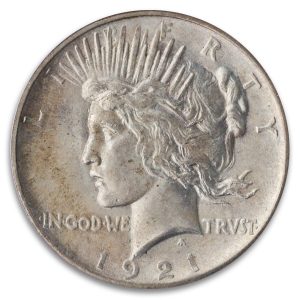
The 1921 Peace Dollar has origins dating back to 1878 when Congress passed the Bland-Allison Act. This measure required the Treasury to make a monthly purchase of $2 million in silver for the sole purpose of converting the metal into silver dollars. These pieces carried the name Morgan Dollar because their design came from engraver George T. Morgan.
However, by 1918 World War I had wreaked havoc. In an attempt to destabilize the British, Germany began a deception campaign aimed at convincing the public that England was unable to sufficiently back their paper currency with silver. As a result, more people began to hoard silver. Prices increased which caused further troubles for Britain. America stepped in to help, selling England more than 270 million silver coins at $1 per ounce. In doing so, nearly half of the Morgan Dollars minted at that point were melted and shipped abroad.
Soon, the U.S. needed to strike new silver dollars in accordance with the Bland-Allison Act. Some suggested designing these new coins to commemorate the end of The Great War, later known as World War I. Charles Moore, the U.S. Commissioner of Fine Arts, and sculpture James Earle Fraser, convened with the mint director to organize a competition for the design of the new piece. A group of artists would be invited to submit designs with an award of $1,500 going to the winner.
However, when the plan for a Peace Dollar was introduced as a joint resolution it met with some resistance. Fortunately, advocates for the peace dollar were able to move forward with their plans because the Morgan dollar had been in production for over 25 meaning it was now officially subject to change per the provisions of the Bland-Allison Act.
The youngest of the designers at 34, Anthony de Francisci, won. His design took direct inspiration from his wife. Francisci used her profile as the basis for his rendering of Liberty.
Other aspects of his design drew harsh criticism. One side of the coin showed an eagle breaking a sword in a symbol of peace and end to war. Some thought the broken sword was too representative of someone who has disgraced themselves. These objections grew with the mint receiving a significant number of complaints. The complicated emotions surrounding World War I still loomed large and many Americans felt this image cast a deeply unfavorable image of the U.S. Eventually, the broken sword was removed from the design.
By January 3, 1922 the Peace Dollar was ready to enter circulation. Francisci himself purchased 50 coins, however, his motivation was not sentimental. According to the 2005 book Renaissance of American Coinage book author Roger W. Burdette explains that Francisci purchased to coins to settle bets he made that he would not win the competition.
By 1922 the Philadelphia, Denver, and San Francisco Mints struck a combined total of 84 million coins. The relief on the coins was so detailed and indelible that it eventually had to be reduced because the dies fractured under the pressure. Today, the coin is an enduring reminder of the power of peace and the talents of one designer who never imagined his design would be seen by so many.
At Blanchard and Company, we’re pleased to offer a wide variety of numismatic rarities. Our history gives us unparalleled expertise in helping collectors and investors find just what they’re looking for. Give us a call today at 800-880-4653 and let us put our 40+ years of experience to work for you.
LaFayette: The Hero of Two Worlds
Posted on — Leave a commentThe man was a national hero in not one country, but two.
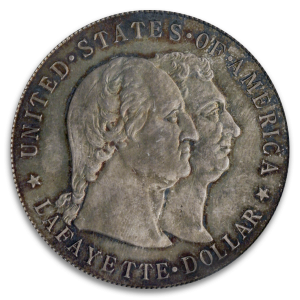
Born in 1757, Gilbert Lafayette came from an ancient noble family in France. By his teen years, Lafayette was orphaned and inherited an immense fortune. He joined the court of King Louis XVI, but yearned for something more meaningful and exciting.
Lafayette wanted to become a soldier and support the colonists in the American Revolution.
At his own expense, Lafayette traveled to the American colonies arriving in Philadelphia nearly two years after the start of the American Revolution.
Only 20 years old, Lafayette was appointed to Major General in the Continental Army and quickly developed a close relationship with another General – George Washington. It is rumored they developed a father-son type of relationship and the aristocratic orphan blossomed under the mentor ship of Washington.
Lafayette took part in the critical final battle as American armies trapped British forces in Yorktown in 1781 ahead of the British surrender. Called the “Hero of Two Worlds,” Lafayette returned to France triumphant.
A Special Coin to Remember and Honor a General
The United States Lafayette Memorial Commission raised funds to build a statue of General Lafayette on horseback for completion in Paris in 1900, in tandem of the Paris World Fair in 1900. The statue was a gift from the United States to honor the brave Frenchman who risked not only his life, but his fortune to support the American Colonists.
The American gift of the statue represented a continuation of the close relationship between the United States and France and followed France’s 1886 gift to America of the Statue of Liberty.
The commission also ordered the creation of a Lafayette silver dollar for distribution at the 1900 Paris World Fair.
The Lafayette dollar officially has no date.
That fact, in and of itself, makes it a curiosity within American numismatics.
The U.S. commission wanted the coins to be minted as early as possible, but to feature the date 1900 to represent the date of the Paris Exposition. This violated Mint rules, which forbid the antedating of a coin.
The Philadelphia Mint circumvented that rule by inscribing: ERECTED BY THE YOUTH OF THE UNITED STATES IN HONOR OF GEN. LAFAYETTE / PARIS 1900 on the reverse of the coin.
The “1900” refers to the date the statue was to be erected. The 1900 Commemorative Silver Dollar features Lafayette on horseback on the reverse, and alongside his close friend and mentor General George Washington on the obverse.
Designed by Chief Engraver Charles Barber, this was the U.S. Mint’s first-ever commemorative silver dollar. Perhaps even more significant, it is the first U.S. coin to ever feature a U.S. President.
The survival rate is pegged at 25,000 for these remarkable coins. The outstanding MS-65 specimens are a rarity and highly sought after. Considering all the silver commemorative coins in U.S. history, collectors consider the Lafayette dollar in higher Mint State levels one of the hardest to obtain.
Why Central Bank Gold Purchases Are at a Six-Year High
Posted on — Leave a commentCentral banks purchased more gold in the first quarter of 2019 than any other first quarter in the last six years. In fact, purchasing was so strong that reserves increased by 68 percent compared to Q1 of 2018. Moreover, this recent surge is part of a larger trend. Consider that in 2018 central banks purchased the second largest annual amount of gold on record. This total reached 651 metric tons outpacing 2017 by more than 70 percent.

What drove the $27.7 billion in central bank gold purchases last year, and what is keeping the trend alive in 2019?
Many have focused on Russia in their attempts to understand the run up in purchases. Reports have noted that “the Russian central bank sold almost all of its U.S. Treasury stock to buy 274.3 tons of gold in 2018.” This strategy represents their decisive move away from the U.S. dollar to gold, an asset often considered to be a safe haven in times of economic turmoil. Though the U.S. economy is in entering the 11th year of expansion making it the longest in history, some fear that problems lay ahead. The trade war threatens future growth and as analysts at J.P. Morgan Chase remarked, “in absolute terms, the nation’s debts are at an all-time high.” This heightened debt is mirrored on the consumer side of the economy as well. The same report shows that delinquency rates on auto loans presents a troubling picture. The segment of borrowers who have fallen behind by a minimum of one payment is now at its highest level in ten years.
Figures like these are leading many to question how long this historic economic expansion can run. The groundswell of support for gold among central banks seems to indicate these concerns are also shared by international governments. To examine central bank motivations more in depth the World Gold Council surveyed 22 central banks at the end of 2018. They learned that gold’s feature as a safe haven asset was the most significant reason for their purchases. The next three reasons for their purchases, in descending order of importance were, “effective portfolio diversifier,” “universally accepted,” and “historical position.”
What makes these reasons so compelling is the fact that they also represent the key reasons why most individual investors purchase gold. Just as central banks choose to buy gold as part of their long-term strategy, investors should similarly consider how this universal currency will diversify their portfolio, as a safe haven asset.
The key takeaway for investors is that central banks around the globe are united in their opinion that increasing their gold reserves is a good strategy. This trend is even more important when viewed in the context of an increasingly global economy in which one nation’s actions have an impact on another. Put simply, the decision by one central bank to increase their gold holdings is a key reason in itself for another country to follow suit. Investors can take cues from this global trend and evaluate how gold might be a smart long-term move for themselves.
Where Precious Metals and Rare Earth Metals Meet
Posted on — Leave a commentFrom the outset it should be made clear that rare earth metals do not included gold and silver. Rare earth metals, now a focus of the simmering trade war with China, are in fact a group of 17 elements found on the periodic table. Moreover, they are not particularly rare especially in comparison to more commonly known metals like copper. The reason they carry “rare” in their name is because they are rarely found in concentrated deposits. Therefore, extracting and isolating a rare earth metal demands a considerable economic outlay.

China is in a position to leverage their control over these elements because they supply about 80 percent of our imports of rare earth metals. These resources are critical to components in everyday devices like fuel cells, smartphones, plasma screens, medical treatments, and even fertilizers. As technological innovation continues to grow, manufacturers have found more uses for rare earth elements. Additionally, rare earth metals are an increasingly prevalent component in low-carbon technologies.
Though rare earth metals have nothing to do with gold and silver, their role in the trade war does have implications for precious metals.
Given the prevalence of rare earth metals in so many goods, investor in the US have become fearful of the long-term impact of China’s recent threats to dramatically cut exports of rare earth metals. The threat has stoked fears of a global economic slowdown. These fears are evident from recent downturns in the stock market. Investors are seeking assets that are less sensitive to this kind of economic upheaval. For many, that means precious metals are a top choice.
As a result, gold reached a seven-week high on the last day in May as threats of new US-issued tariffs on Mexico surfaced. Recently, President Trump announced that he plans to initiate a 5 percent tariff on all goods from Mexico starting on June 10th. “People are doing fear trade now and running towards gold,” remarked Michael Matousek, head trader at U.S. Global Investors.
Investors who are retreating from stocks amid these developments need other investments to help them drive returns. Gold and silver are strong options for a few reasons:
- US interest rate futures are rising. This signals that most traders believe that at least one interest rate cut is likely imminent. In such a case gold would become a more attractive investment because it reduces the opportunity cost of holding a non-interest-bearing product.
- Historically, uncertainty depresses stock market gains. Such drops in the S&P 500 are likely to reinvigorate interest in gold and drive prices upward as we have seen in recent weeks.
- We are at the start of these trade wars and investors who adjust their asset allocation in favor of “safe-haven” investments like gold and silver early are positioned to preserve the wealth as an unpredictable story unfolds.
The bottom line: It is not clear where this journey will lead. However, what we do know is that the journey has in fact started and that the negative effects are already apparent in several investment markets. Now is the time to take cues from the global economic climate and consider precious metals.








